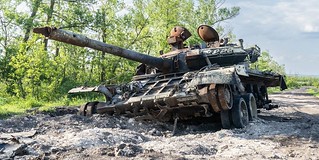A nostalgic detail of a United States Marine unit remembering World War II
The United States Marine Corps is the largest naval infantry force in the world. The Corps was founded in 1775 and has a long history.
Today, U.S. Marines are identifiable by their MARPAT pixelated camouflage uniforms (popularly known as "cammies" in the Corps). This camouflage comes in two versions: a desert one worn in the summer and a woodland one worn in the winter.
The USMC is known for its strict adherence to uniform standards, but there are sometimes certain liberties during the deployments of its various units. An example of this can be seen in two series of photos of the 31st Marine Expeditionary Unit (31 MEU) taken in the Philippine Sea a few weeks ago aboard two US Navy ships: the amphibious assault ship USS Green Bay (LPD-20) and the mobile expeditionary base USS Miguel Keith (ESB-5).
These photos show several USMC members during a visit, board, search and seizure (VBSS) exercise aboard both ships. The Marines in these photos are wearing Barrett MRAD sniper rifles, known as Mk22s in the USMC, and Enhanced Combat Helmets (ECH), a model used since 2012 by the US Marines and Army.
The most interesting and striking thing about these photos is that some of the Marines are wearing Frog Skin camouflage covers on their helmets. This camouflage began to be used by the Marines in World War II, specifically in 1942. Its official name was M1942 Reversible Spot Pattern. The first unit to use it were the Marine Raiders.
Camouflage was used on M1 helmets with a reversible cover. On one side there was a mottled camouflage in green tones for wooded and jungle environments, and on the other there was an identical camouflage but in sandy tones, for desert environments. The Marines used these reversible covers until the 1960s, being replaced by the famous Mitchell camouflage during the Vietnam War, which was also provided with reversible covers in two versions (woodland, which was the most famous, and desert, in brown tones).
The Frog Skin variant seen in these photos is the desert version. In addition, one of the Marines is wearing a 1981 Woodland camouflage cover on his helmet, which replaced the Mitchell. The use of the Frog Skin (now sold in commercial variants) is a nostalgic detail for the Marines in a year that commemorates the 75th anniversary of such famous battles as Saipan, Guam and Peleliu, to name a few battles in which the USMC used Frog Skin camouflage on their helmets.
---
Photos: U.S. Marine Corps / Cpl. Vincent Pham.
|
Don't miss the news and content that interest you. Receive the free daily newsletter in your email: |
- Most read
- The new Frecce Tricolori planes and their new design, a work of Pininfarina
- An excellent documentary shows the inside of the B-17 Flying Fortress bomber
- The firearms used by the Pontifical Swiss Guard, the smallest army in the world
- Sierra Army Depot, a huge United States base with hundreds of Abrams tanks stored
- Eurofighter vs F-35: the opinions of professional pilots on these advanced fighters
- The new CADPAT (MT) digital camouflage of the Canadian Armed Forces
- Russian forces have already lost more than 10,000 armored vehicles in Ukraine

 ES
ES













Opina sobre esta entrada: